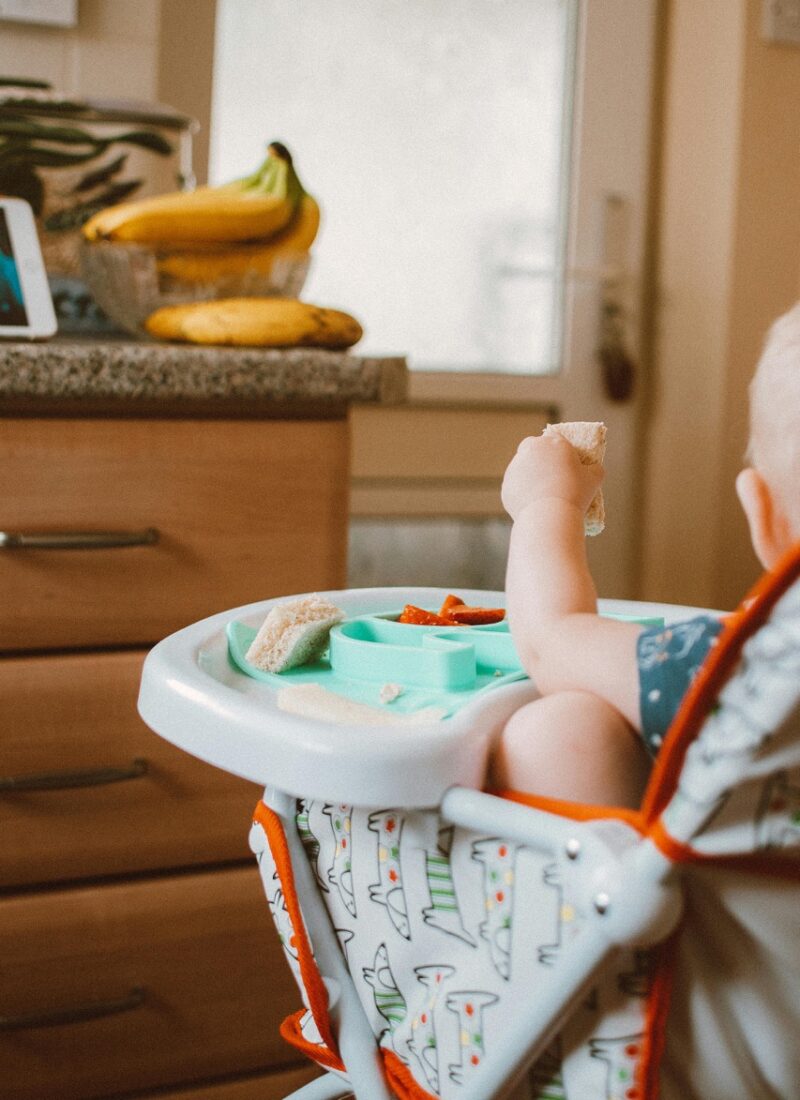When I first became a mom, I was a bit overwhelmed by how much my child was touching me. It sounds silly, but as someone who is not a physical touch person, it was a big adjustment! Between breastfeeding, rocking to sleep, and just wanting to be held, I felt like my baby and I were attached at the hip.
Don’t get me wrong, I loved holding my baby, breastfeeding, and those special rocking moments—but I started to wonder: Would I ever be able to get things done without her attached to me?
Enter: Independent play.
Ever since she was a baby, I really valued letting her play on the floor by herself. Let her move, look around, and wiggle without any interference from me. I had heard that this was a great way for your child to get better awareness of their body and learn how to move.
I had also heard and understood the value of children playing independently. Not only is it great for their imagination and development, it also gives us moms a little bit of a break. (Even if it’s just for 5 minutes)
I started to implement different routines and habits to hopefully get her to play independently. So I could get things done and help her realize she doesn’t need me to play.
Fast forward to now, my daughter is a toddler and she has come a long way when it comes to playing independently. And while she is getting better and better at playing by herself, there are still days where she wants to be attached at the hip with me. That’s just how toddlers and babies are – they want connection with us and sometimes they need the extra love.
It’s no secret that there are so many benefits to children learning to play on their own. Not only does it help them have more autonomy, it fosters creativity & imagination all while boosting their confidence.
So while your toddler may not always want to play alone, there are a few things we can do to encourage independent play, even from a young age.
In this post, I’m sharing the exact steps, routines, and mindset shifts that helped my daughter learn to play independently—so you can create a more peaceful home. Let’s dive in!
Our Child’s Role vs Our Role
One of the first mindset shifts I made was realizing it’s not necessarily my job to entertain my toddler all day. My daughter and I each have roles in our family—hers is to play and learn, mine is to care for our home.
When I had this mindset shift, it took the pressure off me to feel like I had to entertain her all day. Don’t get me wrong, it’s great to have times during the day where you sit down and play with your toddler and do some activities with them. But it doesn’t have to be your whole day.
In fact, I think it’s important for us to model to our children that there are things that need to be done in order for our household to keep running smoothly.
Make Your Home a “Yes” Space
Something that is key to letting your child play on their own is this: Your main spaces in your home need to be “yes” spaces.
What do I mean by a “yes” space? I mean that everything in this room are things your child is allowed to touch and there isn’t anything in the room that could harm them. Now this doesn’t mean they can just terrorize the whole thing, we can still teach boundaries, but for the most part this space is built for toddler play.
If the entire space is completely safe for them, you won’t need to worry about them breaking important things or getting into something that could be dangerous. Not only will this keep you from having to watch them like a hawk, it will give you assurance that if you need to look away for a few minutes, they will be okay.
My brother-in-law once told me, ‘If there’s something in your home you don’t want your kids getting into—get rid of it.’ He probably doesn’t remember saying it, but it stuck with me.
It sounded a little intense to me at first but I quickly learned that it’s true, even if you try to keep things out of reach or hidden in your TV console, your kids will find it. And they will want it to be theirs!
So I made our main living area as toddler safe as I could– outlet covers, no exposed cords, no breakable items, etc. I added areas in our TV console and dining space specifically for her toys. And I only kept other items in the space if I was comfortable with her finding them.
So you might need to remove the breakable home decor in this season. It will give you peace of mind and help your space better support independent play. After all, toddlers live in your home too!
Expand Your Ideas About Play
With your home being a yes space, keep in mind that your toddler’s playing could be with any of your household items, not just toys.
My daughter loves to play with shoes, cake pans, her plates and bowls, etc. Yes, she does play with her toys and books too, but playing for your toddler is exploring and being curious.
I’ll admit, it can drive me a little crazy having her scatter all these random items, but I have to remind myself that she is exercising her independent play muscles and learning about the world from playing with household things.
Try being okay with your toddler taking all the pots and pans out of the cupboard, it doesn’t actually hurt anything! Enjoy a few minutes to yourself and worry about the mess later!
Build Independent Play Into Your Routine
Most toddlers and kids thrive on routines. It helps them to know what’s next and gives them peace knowing what to expect.
So why not make independent play a part of the routine?
For us, one of our routines for independent play is after our meals. I didn’t even really mean for this to happen, but whenever I’m cleaning up the table and doing the dishes after eating, my daughter just seems to know she needs to play by herself and this has become our routine every day.
If my daughter does want me to come play with her during this time while I’m doing dishes and cleaning up, I just plainly tell her what I am doing and that this is a time for her to play on her own. Does it always go well? No. Sometimes she really doesn’t like that answer! But we still try it.
What’s a time in your day that you could consistently add independent play? Is it in the morning while you read your bible, or while you make dinner? Different times might work for different families.
Implementing Independent Play
Okay, so maybe that all sounds great but you’re like, how do I get there?! So I’m here to give you some ideas of how to gently implement independent play.
Slowly increase distance during play
First, start by sitting right next to them while they play. Yep, just sit there. Don’t interact, don’t make comments, don’t ask questions about what they’re doing. Just sit by them so they have the comfort of you being there and let them play! If they involve you, you can of course answer them or take the toy they’re handing to you, but other than that, just sit.
Once you feel like you have graduated from this stage, you can sit by them while they start to play and once they get in a groove, slowly walk away to do something a few feet away. They can still see you and they know you’re there, but just do something else. Start creating a little distance.
They will probably follow you the first few times you walk away, but keep taking them back to their play area and remind them they can keep playing and you will be right there if they need you.
Keep extending the distance little by little until you are able to move around the house doing the things you need to do!
Will it work right away or every time? Probably not.
But eventually they will grow more and more comfortable with playing on their own knowing that you are in the next room doing something else. They will get better at it. It just takes practice and lots of reassurance!
And when they do start to play independently – do not interrupt them. Don’t make eye contact, don’t ask them questions, literally don’t move a muscle if that’s what it takes 😂 You never know how long it will last!
Slow Yourself Down
My next encouragement is to slow down. You might be wondering: What does this have to do with independent play?
Sometimes we can get in such a rush to do the next thing or the next task that we interrupt potential play time for your toddler.
Let me give you an example. The other day, I was trying to get my daughter dressed for the day. I had left the room for a moment to grab something and when I came back, she was happily playing with her stuffed animals.
I could have interrupted her and made her do the task we came in her room to do, but instead I decided to let her keep going. There wasn’t actually a rush for her to get dressed, sure, it was the next task we needed to do to get our day moving, but I am slowly learning that it’s okay if I don’t rush through the day.
She went on to play with her stuffed animals for 20 minutes! Can you imagine if I made her stop? Instead, she played while I did a few other things. Then when she was ready to be done, we got dressed.
So ask yourself, does this thing actually need to happen right this second? Of course, there are times when you really do need to get out the door! But if not, slow down.
Less Toys = More Play
I recently found out that children typically only play with 8-10 toys on average. Even if you have 50 different toys or a playroom full of options, they only tend to gravitate toward a few.
I have found this to be so true for my toddler, the less toys we have out and the better organized it looks, she better she plays.
If you have too many toys out at one time, your child could be overwhelmed by the options or have a hard time focusing on one toy at a time.
Another tip is to have open ended toys– toys that don’t just have one way to play with them. Some examples are toy animals, Magnet Tiles, and baby dolls.
Toy Rotations
You have probably heard of toy rotations, but if not, a toy rotation is when you only have 8-10 toys out at once and as your child becomes less interested in certain toys, you trade them out with a different toy from a collection you keep stored away.
I switch out my daughter’s toys about once a month. I should probably do it more, but that’s just what I’ve landed on for now. When I start to notice toys that aren’t leaving the shelf, I make note that she isn’t playing with that toy anymore so I can put it in storage and replace it.
This will keep your play area less overwhelming and fresh for your toddler to enjoy.
Some of my daughter’s favorite things to play with
- Barn + Farm animals
- Puzzles
- Books
- Baby Dolls
- Wooden Bus
- Stuffed Animals
- Crayons + paper
- Play Kitchen
- Pots & Pans
- Kitchen Utensils & measuring cups
To recap: Here are 7 ways to encourage independent play in your home
- Shift your mindset about your role
- Create a “yes” space
- Let them play with household items
- Add independent play to your routine
- Gradually increase distance during play
- Don’t rush to the next task
- Use toy rotations to reduce overwhelm
Independent play is so good for our kids and for us as moms. But like anything, it takes practice and routine to get your toddler into the habit of playing alone. It takes time and consistency, but it’s worth it. Keep trying, keep adjusting, and celebrate the little wins!
Thanks for reading! Want more peaceful parenting tips like this? Sign up for my weekly newsletter!




Leave a Reply